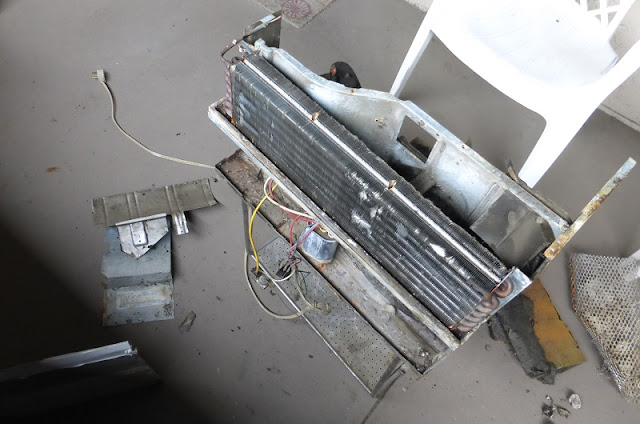I saw this old air conditioner sitting next to the dumpster and was considering taking it apart for some scrap alchemy action. The problem was I didn't want to deal with the freon/refrigerant since I heard it's some pretty nasty stuff and probably illegal to release into the atmosphere. A few days later, I saw that somebody else opened it up and cut off some of the copper tubing thereby taking the responsibility for letting out the freon off my hands... score, now let's take it apart!
My goal was to disassemble it in the most "civilized" way possible without bashing it up and rendering any of the parts useless. Here I've taken off the steel covering. The date of manufacture was marked 1989, and made by Sears. It looked like most of it was made in USA with the exception of the compressor which was of Japanese origin.
This was actually really fun to take apart, it felt like a puzzle since I had to keep turning it around and flipping it over to undo the screws in the correct order to get the parts out properly.
Here's a closer look at the compressor with the copper pipes visibly cut off. The motor appeared to have a dual function; both as a fan to blow the cold air into your house, and on this side as a fan to cool down the compressor.
Some switches from the front panel. I think I took this picture to get the wiring diagram in case I had plans of reconnecting the stuff. The switch on the top appears to have several different settings for the fan speed.
Here is what looks like a double capacitor which is hooked up to both the compressor and the blower motor. Looks like it might've been leaking which could've been what rendered the entire unit defunct (or the sheer amount of dust and junk clogging the air flow). I can't say for certain given my lack of expertise with electronics and refrigeration systems.
Parts everywhere! True indication of scrap alchemy in progress. At this point I had the unit completely disassembled after a coupe hours. The puzzle has been solved!
Another look at the compressor. I think the copper tank looking thing on the side must be the freon reservoir. For those unfamiliar with refrigeration, the compressor squeezes the refrigerant (naturally in gas phase) into a liquid. This generates heat (hence the cooling fan). After which, the liquid refrigerant goes through the radiator where it vaporizes into gas phase again. This is an endothermic process which extracts heat from the surrounding area; the part where it gets cold, and the fan blows the cold air that you like at your face. Anybody whose ever spilled acetone on their hand would know this since it feels really cold from the solvent evaporating so fast; it's the same principal as our body sweat except more rapid.
Unfortunately, these things are tricky to take apart since they're completely sealed and welded together. I'd taken apart one from a refrigerator before, so I imagine it would look similar inside.
Here is the motor for the fans. The shaft sticks out both sides, and that flange to mounted it on the middle panel of the unit. The fact that there are more than 3 wires leading into it gave me the impression of multiple speed settings.
The parts I was really interested in were actually the rotors since I might be able to use them in a foundry blower. The huge disappointment was the revelation that they are both plastic! Nonetheless, the 7 bladed one may be the perfect size to fit my foundry blower.
The radiator mentioned previously. I was thinking this could be used to distill something... perhaps for one of my brother's brewing projects. Alternatively it could be used as an actual radiator for heating by running steam through it. The fins on this appear to be a whole bunch of aluminum stampings stacked around the copper pipe zig zagging though. As backwards as thermodynamics sounds, the goal of the air conditioner is to extract the heat from the surrounding air to make it cold. Therefore wouldn't that make this an "anti-radiator"? I believe this also extracts the moisture from the air as well, which would explain why the ice I left in the freezer keeps getting smaller for no apparent reason.
In the end, I ended up winning. Whoever took off those two 6" lengths of copper tubing clearly missed out on the rest of the copper!












Nice heat exchanger there
ReplyDelete